#AstronomicalObservatories
Text
The Cromlech of Stonehenge
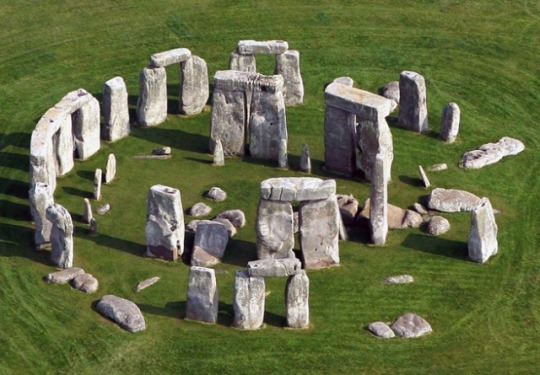
The Stonehenge Cromlech, an ancient marvel towering majestically in the British countryside, represents the most famous and imposing stone circle, known as a cromlech. This extraordinary monument is composed of a circle of colossal megaliths, imposing upright stones that support horizontal connecting lintels, some of which rise impressively in height. Stonehenge is an ancient and fascinating example of a trilithic system, a structure built with three main elements: two vertical uprights and a horizontal lintel.
While the impressive stones of Stonehenge underwent modifications during reconstruction work in the first half of the 20th century, they still maintain an alignment that some believe faithfully reproduces the original one. This precision has led to speculation about Stonehenge's possible role as an ancient astronomical observatory, particularly relevant during solstices and equinoxes. However, the interpretation of its use for this purpose remains a subject of debate.
In addition to attracting tourists from around the world, Stonehenge holds deep significance for followers of Celtic traditions, Wicca, and other neopagan religions. Throughout its history, Stonehenge has also played a significant role as the site of a free music festival held from 1972 to 1984.
However, 1985 marked the end of this festival as the British government banned it following a violent clash between the police and some participants, an incident known as the Battle of Beanfield. Stonehenge, with its rich and varied history, continues to be a source of mystery, fascination, and spirituality for those who visit.
Detailed Description of Stonehenge:
The Altar Stone:
At the center of Stonehenge stands the imposing block of green sandstone known as the Altar Stone. This majestic monolith reaches a height of five meters and captivates with its imposing presence. The stone is carved from an extremely hard variety of siliceous sandstone, naturally sourced from about thirty kilometers to the north on the Marlborough Downs. Its geographical origin adds an element of mystery, highlighting the logistical complexity of ancient builders.
Inner Structure – Bluestone Horseshoe:
Within the main circle is the complex structure known as the Bluestone Horseshoe. This formation consists of much smaller stones, each with an average weight of four tons. Surprisingly, these stones traveled a long distance to reach Stonehenge, originating from the Preseli Mountains in southwestern Wales. The variety of stones, including dolerite, rhyolite, sandstone, and volcanic limestone ashes, adds a unique dimension to the geological complexity of Stonehenge.
The Heel Stone:
Once known as the Friar's Heel, this stone tells a captivating story related to its origins. According to a popular tale dating back at least to the 17th century, the devil himself purchased these stones from a woman in Ireland, wrapped them, and transported them to the Salisbury Plain. While one of the stones fell into the River Avon, the others were strategically placed on the plain. The devil, confident in his cunning, exclaimed, "No one will ever find out how these stones got here." However, a wise friar retorted, "That's what you think!" In response, the devil hurled one of the stones at the friar, striking him in the heel. The stone embedded in the ground, where it remains anchored to this day, a silent witness to an ancient showdown between good and evil.
Historical Mentions and Scientific Investigations of Stonehenge:
The historical roots of Stonehenge extend into the mists of time, capturing the interest of ancient writers and modern scholars. In the 1st century BCE, the Greek writer Diodorus Siculus mentioned a place similar to Stonehenge in his Bibliotheca Historica, referring to an island called Hyperborea, beyond the Celts, dedicated to Apollo. Some scholars in the past have speculated that Hyperborea could indicate Britain, and the spherical temple mentioned by Diodorus could be an early reference to Stonehenge.
However, archaeologist Aubrey Burl has cast doubts on this theory, as some parts of Diodorus's description do not seem to fully reconcile with Stonehenge and its surrounding geography. Burl particularly highlighted the mention of Apollo "touching the earth at a very low height," a phenomenon incompatible with the latitude of Stonehenge.
The earliest detailed investigations into Stonehenge date back to 1640 when John Aubrey proclaimed the monument the work of Druids, an idea later amplified by William Stukeley. Aubrey, a pioneer in site analysis, created the first detailed drawings, laying the groundwork for a better understanding of its form and significance. From 1740 onwards, architect John Wood conducted further research, interpreting Stonehenge as a site for pagan rituals. This interpretation, criticized by Stukeley, reflected the beliefs of the time about the nature of the monument.
Isaac Newton, influenced by Stukeley, undertook a symbolic analysis of Stonehenge's stones in the context of the non-geocentric configuration of the solar system. This perspective, derived from his conception of a perfect model based on the Temple of Jerusalem, suggested that the builders of Stonehenge possessed ancient scientific knowledge.
Radiocarbon dating has revealed that Stonehenge underwent construction phases between 3100 BCE and 1600 BCE, with the circular earthen mound and ditch built in 3100 BCE. The visible stones today mainly belong to the Stonehenge 3 phase (2600 BCE – 1600 BCE). Recent research, such as the 2020 XRF spectrophotometry, has provided new data, indicating a dating of 2500 BCE.
Theories about the construction of Stonehenge, once tied to the Druids, have been challenged considering the late spread of Celtic society. Moreover, the practice of Druid rituals in forests suggests that Stonehenge might not have been the ideal place for their "earth rituals." Ongoing scientific research is gradually unraveling the mysteries of this monument, shedding new light on its past and true nature.
Controversies and Discoveries:
Restorations and Disputes:
Since the early 19th century, a series of modifications and restorations have shaped Stonehenge's current appearance. Victorian engineers, with zeal and preservation intentions, positioned many of the fallen stones in their current locations. Recent research indicates that these restoration works continued into the 1970s, introducing substantial changes to the original arrangement. Archaeologists from English Heritage acknowledge that, without these interventions, Stonehenge would look significantly different today. Very few stones still retain their original positions, erected millennia ago.
Discoveries in the Vicinity:
Just 3 km from Stonehenge, researchers from the National Geographic Society discovered a village dating back to 2600 BCE. This settlement, consisting of approximately twenty-five small dwellings, is presumed to have accommodated builders of the complex or participants in specific ceremonies. This discovery provides a broader insight into the life and social organization of ancient times, connecting Stonehenge's history to a wider context.
Prehistoric Astronomical Observatory:
Stonehenge's function as a prehistoric astronomical observatory is a subject of debate. The monument's axis is oriented towards sunrise during summer solstices, suggesting a connection with astronomy. However, this orientation does not occur during winter solstices, fueling mystery and conflicting interpretations about its real utility. The complexity of Stonehenge continues to intrigue scholars and enthusiasts, and its alleged astral function adds a layer of mystery to its history.
Denial of Roman Theories:
Contrary to the theories of Inigo Jones and others, suggesting that Stonehenge could have been built as a Roman temple, the historical fact that the Romans first arrived on the British Isles with the arrival of Julius Caesar in 55 BCE negates these hypotheses. Stonehenge, with its intricate history and connection to distant eras, continues to challenge and fascinate those seeking to unravel its secrets hidden over millennia.
Theories about Construction:
Extraction and Transport of Large Stones:
The majestic stones of Stonehenge, some of which weigh an impressive 25/50 tons and are made of gneiss, were extracted from a hill located 30 km from the archaeological site. The process of transporting these massive stones involved the use of sledges sliding on wooden rollers, pulled by dozens of men through likely collective efforts. This titanic operation represents an extraordinary expression of engineering capabilities of the time.
Origin of Smaller Stones:
The smaller stones, an integral part of Stonehenge, were extracted from various locations, expanding the logistical complexity of the project. A site just 3 km away contributed some of these stones, while others were extracted from more distant sites, including a location in Wales over 200 km away. The variety of sources underscores the geographic scope of the efforts made for the construction of Stonehenge.
New Research and Rejection of Previous Theories:
A study published in June 2018 challenged the previous theories of geologist Herbert Henry Thomas from 1923, which had influenced the scientific community regarding specific extraction sites and stone transport methods. The new research suggests that the Bristol Channel was not used as previously supposed, but that the stones might have been transported through internal roads. Additionally, it is hypothesized that the Altar Stone could come from Senni Beds, a sandstone formation extending through Wales to Herefordshire in eastern Wales. This conceptual shift sheds new light on the intricate logistics of Stonehenge.
Erection and Construction Process:
The raising of the vertical stones involved a complex process. Initially, the stones were dragged to a hole in the ground, then slid into the hole using a lever system resting against a "castle" of logs. Once in the upright position, the stones were secured using ropes, and the hole was filled with stones. The assembly of the lintel occurred gradually, using wooden scaffolding and levers, highlighting the technical mastery of Stonehenge's prehistoric builders.
Legends and Myths Surrounding Stonehenge:
Association with King Arthur:
Stonehenge is shrouded in the legend of King Arthur, where the wizard Merlin would have requested the removal of the monument from Ireland, originally built on Mount Killaraus by giants who transported the stones from Africa. After being rebuilt near Amesbury, the legend states that Uther Pendragon and later Constantine III were buried inside the stone circle. This mythical connection adds an epic charm to Stonehenge's story, intertwining the ancient monument with the legends of one of Britain's most famous rulers.
Similar Neolithic Circles:
Stonehenge is not the only prominent Neolithic circle, and several similar structures date approximately to the same era. Among these, the "Ring of Brodgar" in northern Scotland offers another example of Neolithic complexity. Additionally, a similar circle, dating to around 4900 BCE, is found in Goseck, Saxony-Anhalt, Germany. These structures suggest the presence of ancient communities sharing ideas and construction practices.
Calendar Circle at Nabta Playa:
A complex known as the "Calendar Circle," originally built at Nabta Playa and now displayed at the Nubian Museum in Aswan, predates Stonehenge by at least a thousand years. This ancient structure, with its astronomical implications, highlights the diversity and spread of construction practices in ancient times.
Megalithic Circles in Italy:
In Italy, several examples of megalithic circles are found in Sardinia, adding a touch of mystery and global connection. The "Circle of Li Muri" in Arzachena and the "Circle of Pranu Muttedu" in Goni are examples of ancient megalithic achievements that emphasize the presence of common practices in different regions of the ancient world. These testimonies speak of a past rich in symbolism and meaning, where communities expressed their connection with the divine through majestic stone constructions.
#StonehengeWonders#AncientAstronomy#NeolithicMysteries#HistoricalMonuments#ArchaeologicalDiscoveries#CelticSpirituality#AncientMusicFestival#DruidicTraditions#PrehistoricEngineering#HistoricalLegends#StonehengeHistory#MegalithicWonders#NeolithicCircles#AstronomicalObservatories#ArchaeologicalInsights#AncientRituals#StonehengeFacts#MysteriousPast#CulturalConnections#AncientCivilizations#MegalithicHeritage
0 notes
Text
Stonehenge Mysteries: Men, Mystery, and a Marvel of a Monument
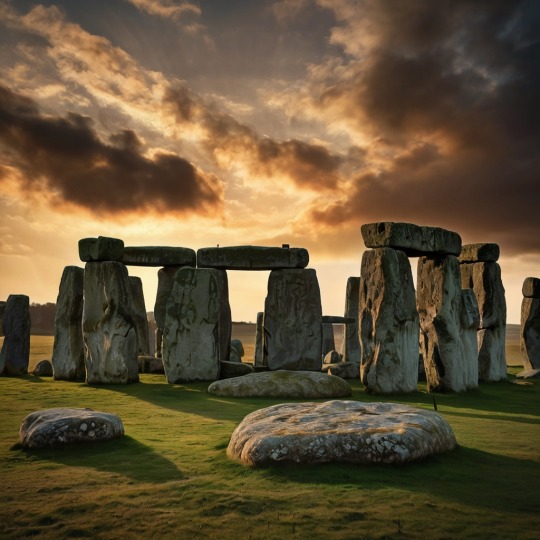
Stonehenge is a megalith organized on the Salisbury Plain in Wiltshire, England, and like all ancient monuments, it has been fascinating for centuries. The construction of the pillars that form the ceiling is thought to be so tall and symbolic that it creates curiosity. Though the available knowledge regarding Stonehenge remains unbiased, several issues are still mired in controversy. This typical blog post focuses on Stonehenge mainly in terms of the purpose of its construction, the methods used in construction, and the celestial purpose that was assigned to the stone circle.
The Purpose of Stonehenge
Arguably, one of the most frequently asked questions about Stonehenge is about the monument’s function. There are a number of theories that, when examined, are proffered with much rationale as to why they should be accepted.

A Ceremonial Site
Due to its construction complexity and its specific layout, Stonehenge was expected to be used ceremonially. This indicates that it was used in religious observances since it has an alignment with the sun solstices of the summers and winters. The main structure of the Heel Stone was placed to align itself with the sun rise on the summer solstice, which suggests solar cult or agricultural rituals.
A Burial Ground
A study carried out on human bones pulled from various digs in and around Stonehenge suggests that it served as the burial place of individuals. Cremated remains were observed at the site, indicating that it was one of the important burial grounds for the elites or people of higher rank in that period and was in use as early as 3000 BC. But this theory fits with the belief that Stonehenge was built as a shrine for ancestor spirits.
A Healing Center
There are theories that certain elements of the monument, as well as the placement of Stonehenge as a whole, were intended to allow for this. A couple of skeletons bearing marks of diseases and wounds that may have been fatal imply that those in ailing states could trek to the shrine with the hope of being healed. The bluestones used in the construction of the circle were believed to have healing virtues, and these originated in Wales.
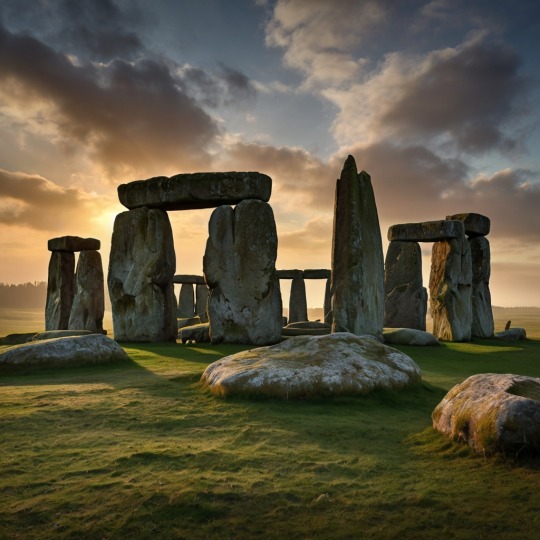
An Astronomical Observatory
One of the dominant theories is that the grand monument was an ancient observatory, and the stones were aligned with specific stars. This is consistent with the idea since the precise laying down of stones correlates with the occurrence of solstices and equinoxes. It could have probably been utilized in the prediction of astronomy, which helped in agriculture and the scheduling of religious ceremonies.
The Construction of Stonehenge
Historians and archaeologists have marveled at the creation of Stonehenge, which is a circle of stones. No technology was available, and yet it was quite intriguing how the prehistoric people moved and set up those large stones.
Transporting the stones
Stonehenge consists of two types of stones: sarsen stones and bluestones of the neolithic period from western Asia and Europe, respectively. The giant sarsen stones, which each weigh up to 25 tons, may have come from the Marlborough Downs, located 32 kilometers away. These were the smaller bluestones that could weigh up to 4 tons and were transported from Preseli Hills in Wales, more than 240 km away.
Earlier, it was assumed that the construction was transported using sledges and rollers, and later through water bodies. Such an immense operation would have necessitated proper planning in terms of human labor and advanced engineering.
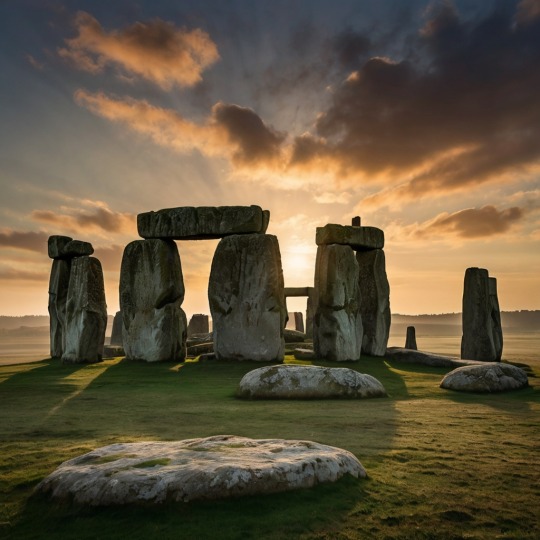
Erecting the Stones
Even when the stones were on site, another problem arose as to how best to put them up or raise them. Currently, ancient writers have posited that prehistoric builders employed a system of earth ramps and wooden beams to lift the construction pieces and maneuver them to their appropriate positions. The lintels, or horizontal stones, were fitted and locked in position through the use of mortise and tenon joints, a sign of the high technicality that had been attained.
Precision and planning
Because there are only megaliths arranged in a circular fashion within the walls of Stonehenge, constructing the monument was a highly precise undertaking that needed careful planning as well as knowledge of geometry and astronomy. They are arranged neatly in a cyclic fashion, and several of them are oriented in specific positions depending on the rightful rites associated with stars. The sophistication of the measurements and the accuracy of the alignments show the builders must have been skilled people with knowledge.
Celestial Alignments
Another interesting historical fact about Stonehenge is that the construction of the circle was to have some kind of correlation with some astronomical phenomena. The feature has had people believing that it was used for astronomical purposes since it was created.
Solstices and Equinoxes
Arising from the above, it can be well argued that Stonehenge was well-aligned to create a solar calendar with shadow markers that pointed directly to the summer and winter solstices. As such, during the summer solstice, the sun reverses its position over the Heel Stone, rises directly at the monument, and provides a shadow through the heart of the stones. This formation can be observed during the shortest day of the year, the winter solstice, when the sun sets in the direction of the Altar Stone. Such alignments indicate that Stonehenge wanted to signify the change of seasons, something that was indeed important in civilizations that dealt with farming.
Lunar Alignments
However, it is not only solar alignments that have been associated with Stonehenge; lunar relationships are evident as well. Some stones are oriented north-south, east-west, and large stones lie parallel to the moon; the builders may have monitored the lunar cycle. It could have been used to estimate eclipses of the moon or some other event, and this has been achieved when its current facet aligns with a past instance.
When can Stonehenge be crowned as having the enduring mystique of Stonehenge?
Nonetheless, the mystery enveloping Stonehenge remains intact since there are countless theories developed by researchers, but the monument still has many secrets. The intent behind its creation, the architectural techniques used in building it, and the connection with astronomy continue to be the objects of discussion and wonder. These monuments oppose the question of historical relevance by holding immense aesthetic and cognitive appeal for multi-generational scrutiny.
Stonehenge is not just a set of stones set together; it is a dynamically creative structure erected by our forefathers. This alignment with the stars, together with the effort that went into the construction of the monument, shows how the value system of paleolithic people pegged heavily on the physical environment.
It does make you think that as people carry on digging around Stonehenge and researching it, will more features and facts surrounding the monument be revealed? Nevertheless, the true purpose of Stonehenge can be explained only in riddles, and a shadow of it is still being whispered to inspire and amaze people around the world, all the while making them think about our ancestors’ genius in the field of architecture.
Thus, having analyzed the mysteries of Stonehenge, we opine that it is beneficial to get closer to understanding the achievements of the ancestors. If, indeed, Stonehenge functioned as a meeting place for the elite to conduct rituals, an emplacement for burying the dead, a sanctuary to solicit healing from gods, or a site to conduct an astronomical calendar, it remains today as a testament to mankind’s wisdom and efforts to learn about the world.
#Stonehenge#Megalith#Mystery#Monument#SalisburyPlain#Wiltshire#England#AncientMonument#CeremonialSite#BurialGround#HealingCenter#AstronomicalObservatory#SolarCult#AgriculturalRituals#AncestorSpirits#HealingVirtues#Bluestones#SarsenStones#NeolithicPeriod#MarlboroughDowns#PreseliHills#Wales#Geometry#Astronomy#SolarCalendar#ShadowMarkers#Solstices#Equinoxes#LunarAlignments#Eclipses
17 notes
·
View notes
Text









World's observatories.
#WorldsObservatories#Observatories#Astronomy#Space#Stargazing#Telescope#Science#AstronomicalObservatory#SkyWatch#Astrophotography#Planetarium#Cosmos#Galaxies#Stellar#ScienceAndTechnology#NightSky#Celestial#AstronomyLovers#SciencePhotography#WorldTravel
15 notes
·
View notes
Photo

Day 22 - The gate #illustration #architecture #fabrikaform #graphic #geometric #form #light #drawing #digital #design #inspiration #minimalist #graphicdesign #gate #interiordesign #colors #abstractart #digitalillustration #space #astronomy #astronomie #astronomicalobservatory #toll #dailydrawing #illustrator
#astronomy#interiordesign#drawing#gate#colors#astronomicalobservatory#fabrikaform#digitalillustration#toll#space#abstractart#dailydrawing#architecture#design#geometric#light#inspiration#digital#illustration#graphicdesign#form#graphic#astronomie#illustrator#minimalist
2 notes
·
View notes
Photo
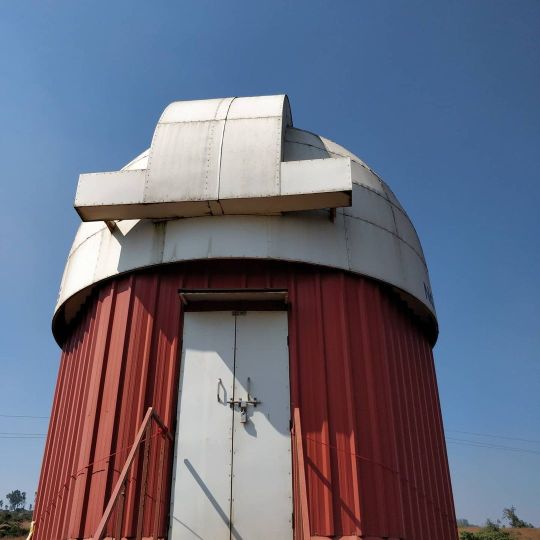
Nature has taken over our facility in these past 8 months as the pandemic caused a pause in travel. This beautiful place will spring back quickly to welcome guests to experience the wonders of our universe. Looking forward to get this place buzzing again.. #natskiesobservatory #astronomy #astronomicalobservatory #spacemuseum #panchgani #spacescienceforall #education #experientiallearning #forceofnature #reload #revive #natskies #travel #experience #explore (at Natventure Camp - Panchgani) https://www.instagram.com/p/CISUxaRp9gU/?igshid=8xavyd9i08am
#natskiesobservatory#astronomy#astronomicalobservatory#spacemuseum#panchgani#spacescienceforall#education#experientiallearning#forceofnature#reload#revive#natskies#travel#experience#explore
0 notes
Photo
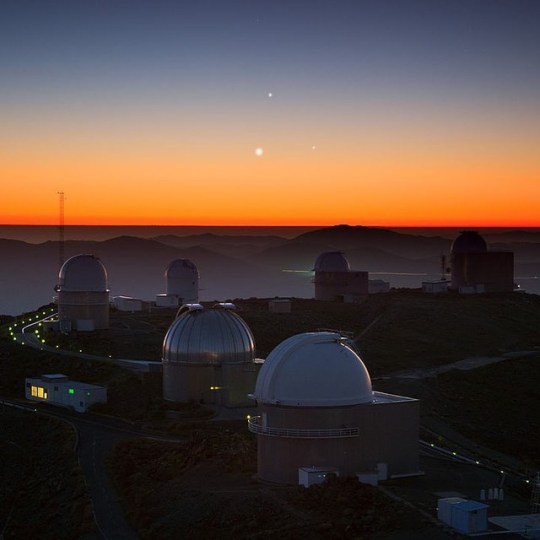
In astronomy, a syzygy is a (roughly) straight-line configuration of three or more celestial bodies in a gravitational system. In this image, taken at La Silla Observatory in Chile, three astronomical objects in the Solar System—Jupiter (top), Venus (lower left), and Mercury (lower right) float together in the Chilean sky. Image credit: ESO/Y. Beletsky #starsandconstellations #conjunction #astronomy #solarsystem #nightskyphotography #chile #goldenhour #astronomicalobservatory https://www.instagram.com/p/B1CiMxZnFqL/?igshid=1gjcg63uelc9h
#starsandconstellations#conjunction#astronomy#solarsystem#nightskyphotography#chile#goldenhour#astronomicalobservatory
0 notes
Photo
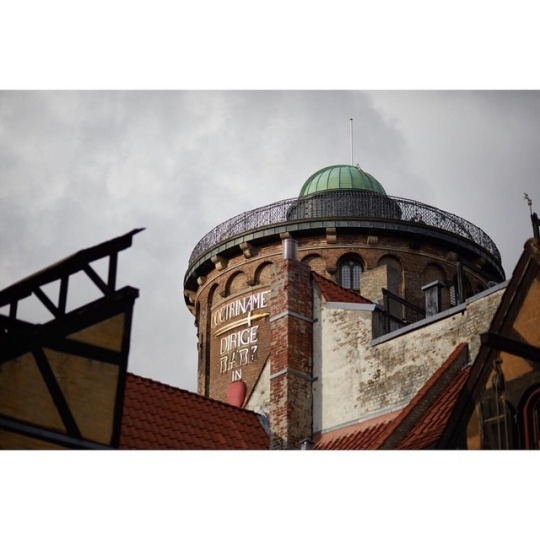
RUNDETAARN #copenhaguen🇩🇰 #danemark #rundetaarn #astronomicalobservatory #instacopenhagen #architecturelovers # (à Copenhagen, Denmark)
1 note
·
View note
Photo
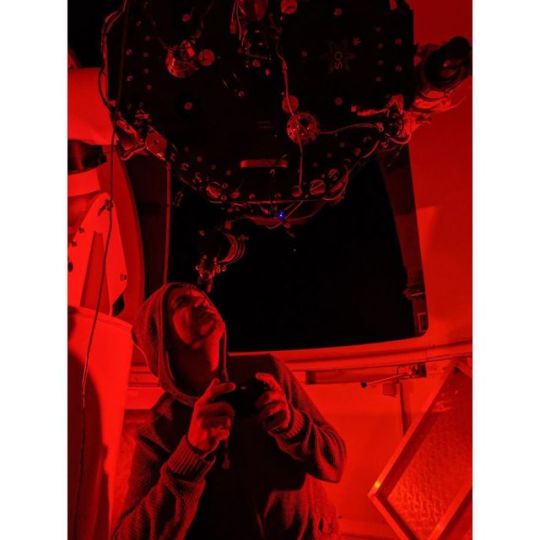
🎮🔭 . . . . . . . #artistresidency #astronomicalobservatory #filipevilasboas #artsonomy #astronomy 📸 @trab_ink (à Mars, Rhone-Alpes, France) https://www.instagram.com/p/B0Q72a0gzzI/?igshid=semihkc155o2
0 notes
Photo

Recently I visited Mt. Mauna Kea and took this picture at sunset above the clouds! They make you stop to acclimate half way up, and I couldn't wait to get to the top to start taking pictures. It was 80 degrees (F) at the base and 35 (F) with a wind advisory at the top. So if you ever go, bring warm clothes! A couple Fun facts: Most of the mountain is under water, and when measured from its oceanic base, Mauna Kea is the tallest mountain in the world measuring over 10,000 m. The 4,200 meter high summit of Maunakea in Hawaii houses the world's largest observatory for optical, infrared, and submillimeter astronomy (University of Hawaii). Hawaii has 4 out of 5 major climate zones in the world (8 out of 13 sub climate zones)! #maunakea #maunakeamountain #observatory #maunakeaobservatory #telescopes #astronomicalobservatory #astronomyphotography #astronomy #sunset #Hawaii #bigisland #sony #nikon #travel #adventure #nightphotography #coolpicture @astronomypicturesdaily @maunakea.summit.adventures (at Mauna Kea Observatories) https://www.instagram.com/p/BwM6YmLJIXy/?utm_source=ig_tumblr_share&igshid=356xyto4tmbr
#maunakea#maunakeamountain#observatory#maunakeaobservatory#telescopes#astronomicalobservatory#astronomyphotography#astronomy#sunset#hawaii#bigisland#sony#nikon#travel#adventure#nightphotography#coolpicture
0 notes
Quote
Suffering Curse, Spiritual Guidance
Call / WhatsApp +27843769238
Powerful Global Social Network Spiritualist Psychic Healer, Spell Caster; Call / WhatsApp: +27843769238, twitter:@healerkenneth, Facebook: psychickenneth offers Love Blessings, Marriages, Jobs, Career, Relationships, Divorce, Breakups, Get New Lover, Separations, Binding, and Stop Fighting & Cheating Partner. Confidential, Personal Guidance, Advice, Direction, Support & answers
0 notes
Video
instagram
Luau Astrônomico em Comemoração aos 15 anos do Espaço de Difusão Científica de Franca no Colégio Champagnat - 22 e 23 de junho, das 19 as 22:30 hs. Traga a Família para essa grande festa da Cultura e do Conhecimento. #governomunicipal #franca #compartilhareavancar #educacao #cultura #ciencia #science #observatorioastronomico #astronomia #astronomy #astronomicalobservatory #mestredecerimonia #ceremonialist #presenter #insta #instaastronomia #instafranca #instapresenter #instagram #followme (em Colégio Champagnat)
#science#followme#educacao#astronomy#cultura#observatorioastronomico#astronomia#mestredecerimonia#instapresenter#instagram#astronomicalobservatory#governomunicipal#compartilhareavancar#franca#presenter#instaastronomia#ciencia#insta#instafranca#ceremonialist
0 notes
Photo

They heard stories about a tribe of natives high in the Andes mountains who had survived 'The Great Flood'. #machupicchu #astronomicalobservatory #ancienttomorrow #gaia #natgeotravel #natgeomundo🌎 (at Machu Picchu)
0 notes
Photo

Day 22 - Observatory in July 🚀 #illustration #architecture #fabrikaform #graphic #geometric #form #light #drawing #digital #design #inspiration #minimalist #graphicdesign #interiordesign #colors #abstractart #digitalillustration #space #astronomy #astronomie #astronomicalobservatory #mirage #dailydrawing #illustrator #pool #research #playground
#geometric#graphicdesign#drawing#astronomie#mirage#architecture#design#digitalillustration#digital#form#space#illustration#minimalist#inspiration#light#illustrator#abstractart#colors#astronomy#astronomicalobservatory#interiordesign#dailydrawing#research#graphic#pool#fabrikaform#playground
1 note
·
View note
Photo

La foto del giorno. “Flower moon” #FlowerMoon #MothersMoon #HareMoon #CornPlantingMoon #milkmoon #fullmoon #iloveyou #月が綺麗ですね #夏目漱石 #満月 #満月の夜 #花月 #月はむずかしい #astronomicalobservatory #moon #moonshot #a7iii #ef24105f4l #sigmamc11 #handheldcamera #handheld #handheldcamera #雲が少しかかっちゃった #なぜか毎月満月撮ってる (Setagaya-Ku) https://www.instagram.com/p/B_5IBCOjHEn/?igshid=uuf2sthx1tvv
#flowermoon#mothersmoon#haremoon#cornplantingmoon#milkmoon#fullmoon#iloveyou#月が綺麗ですね#夏目漱石#満月#満月の夜#花月#月はむずかしい#astronomicalobservatory#moon#moonshot#a7iii#ef24105f4l#sigmamc11#handheldcamera#handheld#雲が少しかかっちゃった#なぜか毎月満月撮ってる
0 notes
Photo
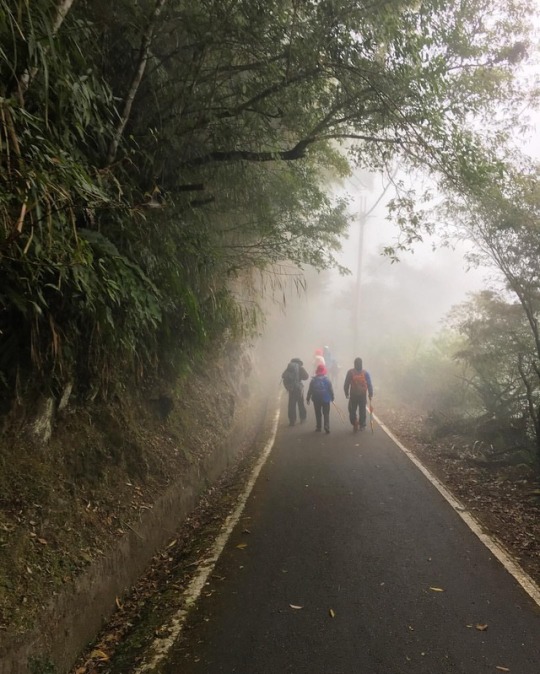
First few people (disappearing in the #mist) we found near the #astronomicalobservatory in #xitou #forest, other than the #taiwanese gleefully ignoring the "no stove cooking" sign at the top (I love #outdoor people in #taiwan, they are my peeps). #expat #abroad (at Xitou Nature Education Area 溪頭自然教育園區)
0 notes
Photo

La foto del giorno “Pink Moon” #superpinkmoon #supermoon #a7iii #nikkor50300f45ais #handheld #handheldcamera #ちょっと遅れちゃったけど #ギリギリ満月 #月はむずかしい #astronomicalobservatory #moon #moonshot (Setagaya, Tokyo) https://www.instagram.com/p/B-uP_BuDZuD/?igshid=1wz208l91nzr4
#superpinkmoon#supermoon#a7iii#nikkor50300f45ais#handheld#handheldcamera#ちょっと遅れちゃったけど#ギリギリ満月#月はむずかしい#astronomicalobservatory#moon#moonshot
0 notes